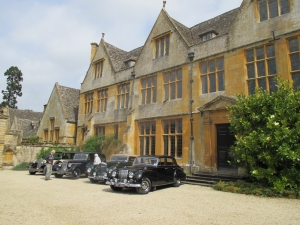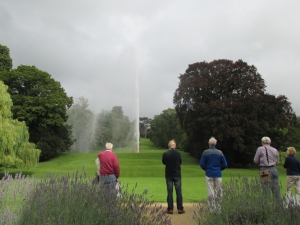STAMPS ON THE CEILING
Friday 29th August was the date and Stanway House the venue. After a light lunch at a local hostelry (how else do you start an ASOC South Midlands meet?) the great doors were opened in the 17th century gatehouse allowing 3 Armstrong Siddeleys and a Bentley to park on the gravel close to the front door of this marvellous historic house (the rest of us, in modern cars had to park outside and walk in!) Nine members of the club along with four guests were soon joined by our guide for the private tour of this fabulous old house complete with a tithe barn and working water mill.

A feature of the exterior stonework of the house repeated in the gutter downpipe junction boxes was scallop shell carvings and mouldings. They seemed out of place until it was revealed that the family of one of the three knights who murdered Thomas a Becket had owned the original house, the shells being a permanent reminder of the 7 year pilgrimage that knight undertook to atone for his deeds.
The house itself was originally a country retreat for the Abbots of Tewkesbury dating from Jacobean times but considerably altered over the years with no detailed plans surviving from earlier than the mid 19th century. Now owned by the Earls of Wemys, its use as a location to dispose of unwanted furniture from Gosford House, East Lothian which is the Earl’s ancestral seat is very evident. An extremely mixed collection of tables, chairs etc. along with a shove-halfpenny table probably made in the room from 1 tree trunk, William Morris soft furnishings, Chippendale Chinese style sofa beds and an outstanding William and Mary marquetry cabinet made for very interesting viewing.
This was topped, in more ways than one, by a party trick attributed to J.M.Barrie (“Peter Pan”) when our guide drew our attention to some small white patches on the very high ceiling in the main room of the house. These were apparently King George V postage stamps that had been licked on both sides, placed on a penny and then flicked up to the ceiling by the said A.A. Milne just over 100 years ago.
The whole house definitely gave the impression of being lived in and has over the years been the setting for various TV drama productions as well as an edition of “Antiques Roadshow”.
The house stands amid extensive lawns, one of which had a female Sphinx in the middle of it. Any thoughts that this may of been in honour of our cars was rapidly dispelled by our guide. The current Earl of Wemys had a favourite aunt who was a keen Egyptologist. The presence of the Sphinx was to be linked to this lady who had a small garden of remembrance, complete with a citation in hieroglyphics, nearby.
There are many grand country houses scattered around the country but very few with a working water-driven flour mill. Once again the monks of Tewkesbury Abbey started things off with a fulling mill (no prickly horse hair vests for that lot!) which then became a corn mill followed by a timber mill before falling into disrepair in the 1950s. Seven years' hard work from 2002 onwards saw the mill returned to its former glory with a new 24’ water wheel and a completely rebuilt interior all powered by water springs on the Cotswold escarpment. Using french burr-quartz mill stones, wheat from the estate is milled into three grades of flour with the husk being separated and sold as bran. After a demonstration and a tour from the rafters to the bagging floor, most of us departed with two bags of flour (one wholemeal and one unbleached white which is really cream coloured).

In good ASOC style there was only one way to cap the visit off, afternoon tea with rather large and extremely tasty pieces of sponge sandwich cake. I noticed that not many pieces were left when the tables were cleared!
Our grateful thanks go to Ian Leighton-Boyce for all the work that it must of taken to organise our extremely pleasant afternoon. Thank you Ian!
Posted in Events on the 10th November 2014 at 11:12am.
Latest Posts
Categories
Archives
Feeds


 The
The
Share: